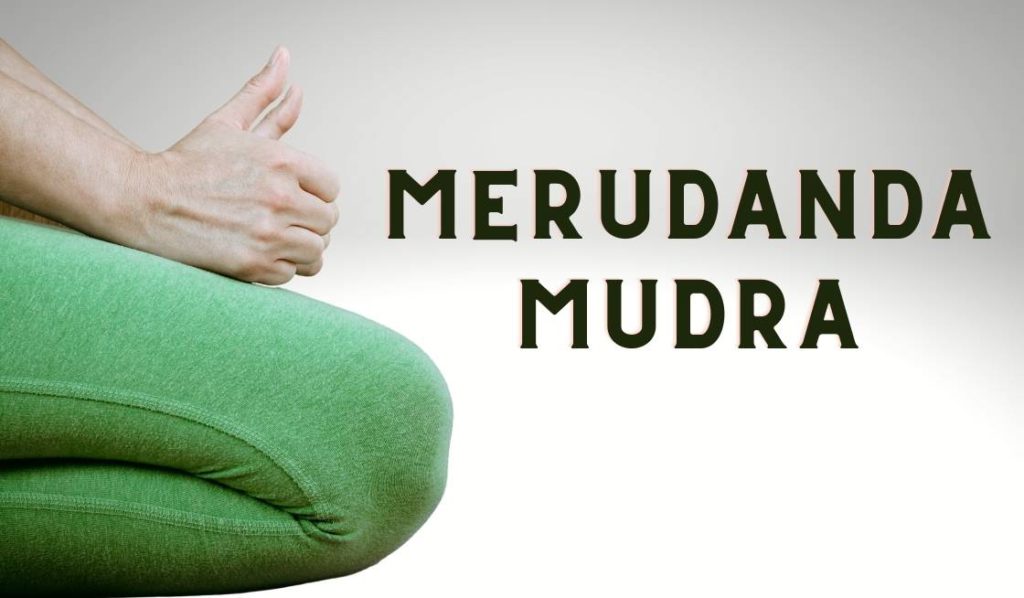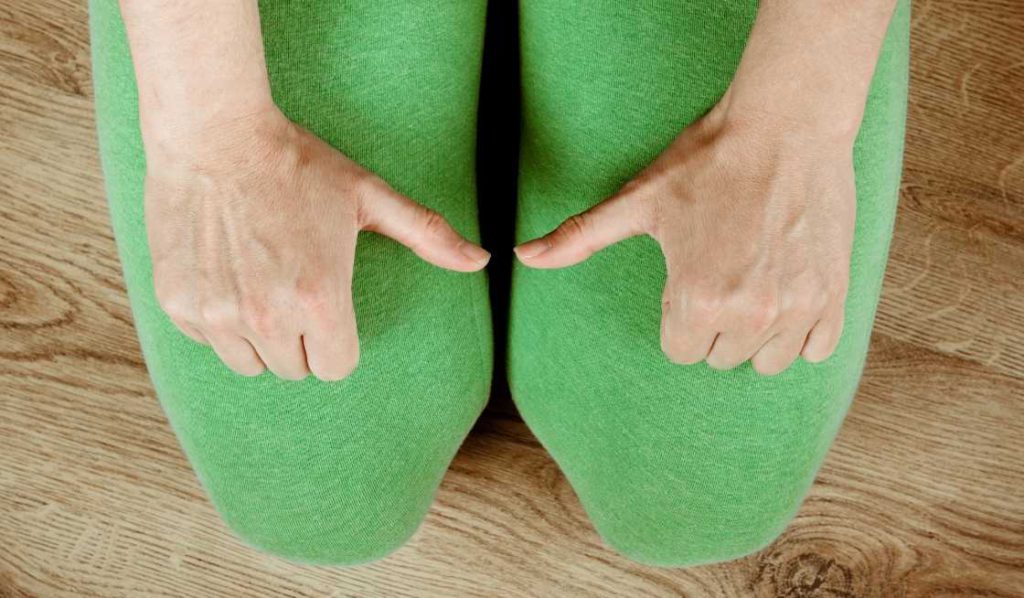>>Download Yoga Mudras Free PDF!

Merudanda Mudra is a powerful hand gesture that supports spinal health. Practising this mudra can help relieve back pain and reduce stress within a few minutes.
To perform Merudanda Mudra, curl your fingers into a gentle fist while keeping the thumbs extended. Rest your hands on your thighs, and with each deep breath, change the direction of your thumbs.
This mudra is commonly used during meditation and pranayama practices. The extended thumbs in Merudanda Mudra are also used in Shambhavi mudra to help adjust the gaze in the initial stages of practice.
Merudanda mudra meaning
In Sanskrit, “merudanda” refers to “spinal column” and “mudra” means gesture. Its practice leaves massaging effects on the spinal column aiding the flow of pranic energy throughout the body.
It is named so because of the soothing and healing effects that it leaves on the spine. It is also referred to as Spine Mudra.
Merudanda mudra is also called guru mudra as the thumb is actively used in this mudra and the thumb is associated with the fire element. Just like a guru (teacher) guides you from darkness to light, the fire element association of this mudra gives you the needed fire energy to guide your path.
Due to the flow of prana throughout the spine, Merudanda mudra helps to activate and balance all the chakras. It also serves as an exercise to improve the focus and concentration of the practitioner.
Mythological aspect of merudanda mudra
In Hindu mythology, there is a sacred golden mountain named Mount Meru, believed to be the abode of the gods. It is said to stand at the centre of the universe, just as the spinal column lies at the centre of the human body, offering structural and energetic support.
The word “Merudanda” is a combination of “Meru” (the cosmic mountain) and “Danda” (scepter or staff). Symbolically, it represents “the staff of Mount Meru,” reflecting the central support of our body the spine. This sacred association gives the mudra both spiritual and energetic significance.
Interestingly, Merudanda Mudra visually resembles a thumbs-up gesture, which universally signals that “everything is okay.” Practising this mudra is believed to promote a balanced, healthy state—physically, mentally, and energetically.
Merudanda Mudra is traditionally performed with the thumb in a central position, but it can also be practised in two other variations, each aligning the thumb in a different direction to enhance the flow of prana.
Adho Merudanda Mudra
In this, both thumbs pointing toward each other.

Urdhva Merudanda Mudra
In this, both thumbs pointing away from each other.

How to Do Merudanda Mudra
Merudanda mudra is completed following Adho merudanda mudra and Urdhva merudanda mudra in sequence as described below:
- Sit in sukhasana or vajrasana keeping your eyes closed.
- Place your hands on your thighs with the palms facing down.
- Curl your fingers towards the palms to form a fist.
- Keep the thumbs extended towards each other (Adho Merudanda mudra).
- Shift your focus towards the slow deep breaths and hold the mudra for 8-10 breaths.
- Roll your hands on your thighs so that the thumb is pointed towards the sky (Merudanda mudra).
- Again, stay in such a position for 8-10 breaths.
- At last, move your hands so that the thumbs are pointed outwards in opposite directions (Urdhva Merudanda mudra).
- Take eight slow breaths holding Urdhva Merudanda mudra.
Precautions and contraindications
- Avoid clenching the fists too tightly, as it may strain the hand muscles or wrists.
- People with severe spinal injuries or chronic back conditions should consult a doctor or yoga therapist before practising.
- Do not practise this mudra while lying down, as it requires an upright seated posture for proper pranic flow.
- Those with recent hand or thumb injuries should avoid or modify the gesture.
- Practise in a calm, quiet space to avoid distractions and maintain focus.
- If you feel any discomfort in the lower back or shoulders, stop and adjust your posture.
- Not suitable for those with high levels of restlessness or anxiety unless done under supervision.
- Avoid practising for long durations in the beginning; start with 5–10 minutes and increase gradually.
Time & duration
Merudanda Mudra can be practised at any time of the day, either while seated in a meditative posture (like Sukhasana or Padmasana) or sitting comfortably on a chair. It can also be performed while standing, making it a convenient and versatile mudra for daily use.
You can practise this mudra as a preparatory or counter mudra to support other yoga asanas or pranayama techniques.
For optimal results, follow this breathing rhythm (4:2:5:2):
- Inhale for 4 seconds
- Hold the breath for 2 seconds
- Exhale for 5 seconds
- Pause for 2 seconds before inhaling again
Start with 5 to 10 minutes per session. As your comfort and focus improve, gradually increase the duration. Regular practice helps promote calmness and supports spinal alignment and energy balance.
Mechanism of working
While performing Merudanda mudra the rotation of the thumbs steers the flow of prana to different regions of the body.
- In Adho Merudanda mudra, when thumbs are pointing towards each other, the prana moves through the lungs and lower abdomen.
- Energy moves through the mid-section of the body as the thumbs are extended upward.
- Finally holding the Urdhva Merudanda with thumbs extended outwards energizes the chest as well as the spine.
- As Merudanda mudra derives pranic energy throughout the spine, it opens all the energy chakras. When is the flow of prana is directed towards the solar plexus (Manipura Chakra), it improves the metabolism to respond better in any stressed situation.
- This mudra is beneficial in opening the sacred energy channel, Sushumna Nadi that helps in achieving enlightenment. This is so because the prana flows from the base of the pelvis to the crown of the head. Hence, it also awakens the Kundalini energy.
- Besides this, Merudanda Mudra also stimulates the thymus gland. It produces hormones beneficial to remove the stress out of the body.
Therapeutic advantages
- Merudanda mudra is a boon to relieve back pain or back strain.
- It rectifies the issue of slip disc if practiced for 30 minutes daily followed by prana mudra for 10 minutes.
- It also helps in curing piles and healing the prostate.
- Diabetic patients also experience healing effects through this mudra.
- It has soothing effects on the nervous system and helps to alleviate stress, anxiety, and other psychological issues.
- It relieves issues like dyspepsia and gastritis by enhancing the digestive fire.
- You can practice this mudra to heal the distended spleen or liver.
Benefits of Merudanda Mudra
Merudanda Mudra has several health benefits that mainly support the spine, breath, and inner balance. When paired with slow, deep breathing, it gently activates your energy channels and improves both physical and mental well-being.
1. Relieves back pain and improves spinal alignment
Merudanda Mudra supports the natural curve of the spine, helping to release tension in the back muscles. Regular practice with deep breathing can ease mild back pain, especially caused by poor posture or sitting for long hours.
2. Supports detoxification and lung expansion
When combined with deep breathing or pranayama, Merudanda Mudra helps expand the lungs, allowing for better oxygen intake. This supports the detoxification process by helping remove toxins through improved oxygen circulation and blood purification.
3. Improves respiratory and circulatory function
This mudra encourages slow, rhythmic breathing, which enhances the function of the respiratory system. The improved breath flow helps regulate the heartbeat and supports healthy blood circulation.
4. Stimulates abdominal organs and boosts digestion
Practising Merudanda Mudra with controlled breathing activates the stomach area, gently massaging the internal organs. This stimulation enhances the efficiency of the liver and kidneys and supports better digestion and metabolic health.
5. Aids in weight management and reduces obesity
By improving digestive fire and balancing energy flow, this mudra supports healthy metabolism. When done regularly with breath control, it can help burn excess fat and reduce obesity-related discomfort.
6. Calms the mind and reduces restlessness
Merudanda Mudra helps activate the parasympathetic nervous system, promoting mental calm and emotional stability. It brings awareness inward and is especially useful for reducing anxiety, restlessness, and scattered thoughts.
7. Strengthens the spine and activates energy channels (Nadis)
This mudra encourages proper posture and spinal alignment, which strengthens the back and core muscles. It also stimulates the flow of prana through the Ida, Pingala, and Sushumna Nadis, enhancing the body’s overall energy balance.
Conclusion
Merudanda Mudra is a simple yet effective practice for improving spinal health and calming the mind. It fits easily into your daily routine and works well with meditation or breathing exercises. Just a few minutes a day can make a real difference in how you feel.
FAQs on Merudanda Mudra
1. Can Merudanda Mudra be practised while walking?
No, Merudanda Mudra should be practised while seated or standing still to maintain posture and breath awareness.
2. Is Merudanda Mudra suitable for beginners?
Yes, it’s easy to learn and suitable for beginners, especially when combined with slow, deep breathing.
3. Can I practise Merudanda Mudra during pregnancy?
It is generally safe, but pregnant women should consult a yoga expert before practising any mudra regularly.
4. How many times a day can I do Merudanda Mudra?
You can practise it 1–3 times a day, depending on your comfort and schedule.
5. Does Merudanda Mudra require mantra chanting?
No, chanting is not required, but you can combine it with a mantra or meditation for deeper focus.
6. Can I do Merudanda Mudra with one hand?
It’s recommended to use both hands for balanced energy flow, but it can be done with one hand if needed.
7. Is there a best time to practise Merudanda Mudra?
Morning is ideal for fresh energy, but it can be done any time during the day when you feel the need for focus or relaxation.
8. Does Merudanda Mudra help with posture correction?
Yes, it encourages upright sitting and awareness of the spine, which can help improve posture over time.

